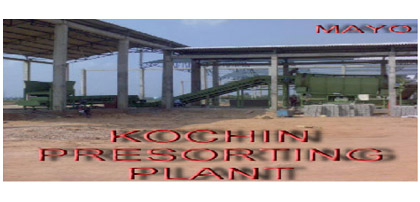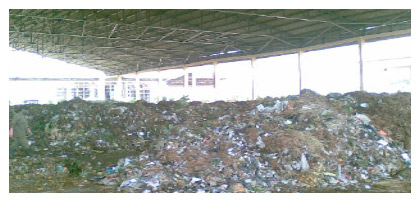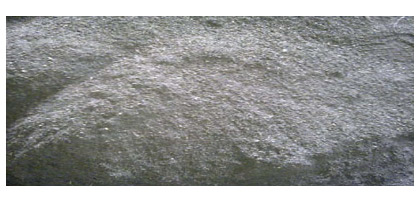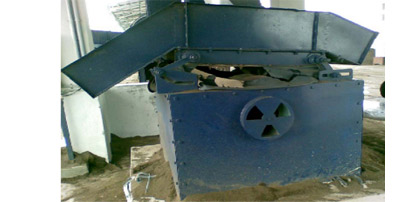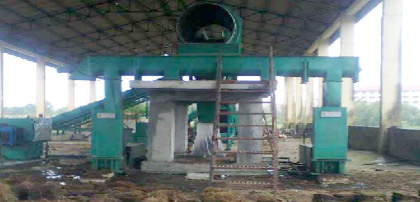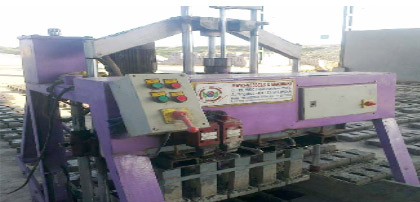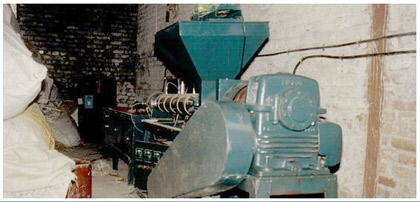Phase I: Making Mushroom Compost
This phase of
compost preparation usually occurs outdoors although an enclosed
building or a structure with a roof over it may be used. A concrete
slab, referred to as a wharf, is required for composting. In addition, a
compost turner
to aerate and water the ingredients, and a tractor-loader to move the
ingredients to the turner is needed. In earlier days piles were turned
by hand using pitchforks, which is still an alternative to mechanized
equipment, but it is labor intensive and physically demanding.
Phase
I composting is initiated by mixing and wetting the ingredients as they
are stacked in a rectangular pile with tight sides and a loose center.
Normally, the bulk ingredients are put through a compost turner.
Water is sprayed onto the pig manure or synthetic compost as these
materials move through the turner. Nitrogen supplements and gypsum are
spread over the top of the bulk ingredients and are thoroughly mixed by
the turner. Once the pile is wetted and formed, aerobic fermentation
(composting) commences as a result of the growth and reproduction of
microorganisms, which occur naturally in the bulk ingredients. Heat,
ammonia, and carbon dioxide are released as by-products during this
process. Compost activators, other than those mentioned, are not needed,
although some organic farming books stress the need for an “activator.”
Mushroom
compost develops as the chemical nature of the raw ingredients is
converted by the activity of microorganisms, heat, and some
heat-releasing chemical reactions. These events result in a food source
most suited for the growth of the mushroom to the exclusion of other
fungi and bacteria. There must be adequate moisture, oxygen, nitrogen,
and carbohydrates present throughout the process, or else the process
will stop. This is why water and supplements are added periodically, and
the compost pile is aerated as it moves through the turner.
Gypsum
is added to minimize the greasiness compost normally tends to have.
Gypsum increases the flocculation of certain chemicals in the compost,
and they adhere to straw or hay rather than filling the pores (holes)
between the straws. A side benefit of this phenomenon is that air can
permeate the pile more readily, and air is essential to the composting
process. The exclusion of air results in an airless (anaerobic)
environment in which deleterious chemical compounds are formed which
detract from the selectivity of mushroom compost for growing mushrooms.
Gypsum is added at the outset of composting at 40 lbs. per ton of dry
ingredients.
Nitrogen supplements in general use today
include brewerâs grain, seed meals of soybeans, peanuts, or cotton, and
chicken manure, among others. The purpose of these supplements is to
increase the nitrogen content to 1.5 percent for horse manure or 1.7
percent for synthetic, both computed on a dry weight basis. Synthetic
compost requires the addition of ammonium nitrate or urea at the outset
of composting to provide the compost microflora with a readily available
form of nitrogen for their growth and reproduction.
Corn
cobs are sometimes unavailable or available at a price considered to be
excessive. Substitutes for or complements to corn cobs include shredded
hardwood bark, cottonseed hulls, neutralized grape pomace, and cocoa
bean hulls. Management of a compost pile containing any one of these compostable organic materials is unique in the requirements for watering and the interval
between turning.
The initial compost pile should be 5
to 6 feet wide, 5 to 6 feet high, and as long as necessary. A two-sided
box can be used to form the pile (rick), although some turners are
equipped with a “ricker” so a box isnât needed. The sides of the pile
should be firm and dense, yet the center must remain loose throughout
Phase I composting. As the straw or hay softens during composting, the
materials become less rigid and compactions can easily occur. If the
materials become too compact, air cannot move through the pile and an
anaerobic environment will develop.
Turning
and watering are done at approximately 2-day intervals, but not unless
the pile is hot (145° to 170°F). Turning provides the opportunity to
water, aerate, and mix the ingredients, as well as to relocate the straw
or hay from a cooler to a warmer area in the pile, outside versus
inside. Supplements are also added when the ricks are turned, but they
should be added early in the composting process. The number of turnings
and the time between turnings depends on the condition of the starting
material and the time necessary for the compost to heat to temperatures
above 145°F.
Water
addition is critical since too much will exclude oxygen by occupying
the pore space, and too little can limit the growth of bacteria and
fungi. As a general rule, water is added up to the point of leaching
when the pile is formed and at the time of first turning, and thereafter
either none or only a little is added for the duration of composting.
On the last turning before Phase II composting, water can be applied
generously so that when the compost is tightly squeezed, water drips
from it. There is a link between water, nutritive value, microbial
activity, and temperature, and because it is a chain, when one condition
is limiting for one factor, the whole chain will cease to function.
Biologists see this phenomenon repeatedly and have termed it the Law of
Limiting Factors.
Phase
I composting lasts from 7 to 14 days, depending on the nature of the
material at the start and its characteristics at each turn. There is a
strong ammonia odor associated with composting, which is usually
complemented by a sweet, moldy smell. When compost temperatures are
155°F and higher, and ammonia is present, chemical changes occur which
result in a food rather exclusively used by the mushrooms. As a
by-product of the chemical changes, heat is released and the compost
temperatures increase. Temperatures in the compost can reach 170° to
180°F during the second and third turnings when a desirable level of
biological and chemical activity is occurring. At the end of Phase I the
compost should: a) have a chocolate brown color; b) have soft, pliable
straws, c) have a moisture content of from 68 to 74 percent; and d) have
a strong smell of ammonia. When the moisture, temperature, color, and
odor described have been reached, Phase I composting is completed.
Phase II: Finishing the Compost
There
are two major purposes to Phase II composting. Pasteurization is
necessary to kill any insects, nematodes, pest fungi, or other pests
that may be present in the compost. And second, it is necessary to
remove the ammonia which formed during Phase I composting. Ammonia at
the end of Phase II in a concentration higher than 0.07 percent is often
lethal to mushroom spawn growth, thus it must be removed; generally, a
person can smell ammonia when the concentration is above 0.10 percent.
Phase
II takes place in one of three places, depending on the type of
production system used. For the zoned system of growing, compost is
packed into wooden trays, the trays are stacked six to eight high, and
are moved into an environmentally controlled Phase II room. Thereafter,
the trays are moved to special rooms, each designed to provide the
optimum environment for each step of the mushroom growing process. With a
bed or shelf system, the compost is placed directly in the beds, which
are in the room used for all steps of the crop culture. The most
recently introduced system, the bulk system, is one in which the compost
is placed in a cement-block bin with a perforated floor and no cover on
top of the compost; this is a room specifically designed for Phase II
composting.
The
compost, whether placed in beds, trays, or bulk, should be filled
uniformly in depth and density or compression. Compost density should
allow for gas exchange, since ammonia and carbon dioxide will be
replaced by outside air.
Phase
II composting can be viewed as a controlled, temperature-dependent,
ecological process using air to maintain the compost in a temperature
range best suited for the de-ammonifying organisms to grow and
reproduce. The growth of these thermophilic (heat-loving) organisms
depends on the availability of usable carbohydrates and nitrogen, some
of the nitrogen in the form of ammonia.
Optimum
management for Phase II is difficult to define and most commercial
growers tend toward one of the two systems in general use today: high
temperature or low temperature.
A
high temperature Phase II system involves an initial pasteurization
period during which the compost and the air temperature are raised to at
least 145°F for 6 hours. This can be accomplished by heat generated
during the growth of naturally occurring microorganisms or by injecting
steam into the room where the compost has been placed, or both. After
pasteurization, the compost is re-conditioned by immediately lowering
the temperature to 140°F by flushing the room with fresh air.
Thereafter, the compost is allowed to cool gradually at a rate of
approximately 2° to 3°F each day until all the ammonia is dissipated.
This Phase II system requires approximately 10 to 14 days to complete.
In
the low temperature Phase II system the compost temperature is
initially increased to about 126°F with steam or by the heat released
via microbial growth, after which the air temperature is lowered so the
compost is in a temperature range of 125° to 130°F range. During the 4
to 5 days after pasteurization, the compost temperature may be lowered
by about 2°F a day until the ammonia is dissipated.
It
is important to remember the purposes of Phase II when trying to
determine the proper procedure and sequence to follow. One purpose is to
remove unwanted ammonia. To this end the temperature range from 125° to
130°F is most efficient since de-ammonifying organisms grow well in
this temperature range. A second purpose of Phase II is to remove any
pests present in the compost by use of a pasteurization sequence.
At
the end of Phase II the compost temperature must be lowered to
approximately 75° to 80°F before spawning (planting) can begin. The
nitrogen content of the compost should be 2.0 to 2.4 percent, and the
moisture content between 68 and 72 percent. Also, at the end of Phase II
it is desirable to have 5 to 7 lbs. of dry compost per square foot of
bed or tray surface to obtain profitable mushroom yields. It is
important to have both the compost and the compost temperatures uniform
during the Phase II process since it is desirable to have as homogenous a
material as possible.
Related Reading:
Olive Mill Waste Composting Technology
Benefits of Compost
Cow Dung Composting
29.12.16
28.12.16
All kinds of fertilizer granulator, fertilizer granulation machine
Import and Export Trade Leads from Around the World - TradeNote.net - Manufacturers, Exporters, Suppliers, Manufacturers Suppliers Exporters Importers,, Companies, Factories.
Allance Fertilizer Machinery provides all kinds of fertilizer granulators.
1. Our rotary granulator is used to make raw materials into specified ball shape particles. The granulation rate is quite high, so it is mainly used for large-scale compound fertilizer production.
2. New type organic fertilizer dedicated granulator is used for producing pure organic fertilizer in a more eco-friendly way. Thus, it makes the whole producing process more energy-saving and economic.
3. The bio-fertilizer spherical granule granulator manufactured by us adopts advanced technology to promise uniformly spherical shape of the end products. It consists of flat die extrusion granulator and organic fertilizer polishing machine.
4. Flat Die Extrusion Granulator is used for organic fertilizer production. Different from the traditional fertilizer production methods, it can make the producing processes more efficient,and the granulation process more energy-saving.
5. Our disc fertilizer granulator can use wide resources of raw materials to produce organic fertilizer and compound fertilizer. It is perfectly designed to ensure its smooth running and long service life.
6. Our double roller extrusion granulator can produce various concentrations of compound fertilizer. Granules shape produced by this fertilizer granulator is oblate. It saves energy and cost, no water or air pollution.
Allance Fertilizer Machinery provides all kinds of fertilizer granulators.
1. Our rotary granulator is used to make raw materials into specified ball shape particles. The granulation rate is quite high, so it is mainly used for large-scale compound fertilizer production.
2. New type organic fertilizer dedicated granulator is used for producing pure organic fertilizer in a more eco-friendly way. Thus, it makes the whole producing process more energy-saving and economic.
3. The bio-fertilizer spherical granule granulator manufactured by us adopts advanced technology to promise uniformly spherical shape of the end products. It consists of flat die extrusion granulator and organic fertilizer polishing machine.
4. Flat Die Extrusion Granulator is used for organic fertilizer production. Different from the traditional fertilizer production methods, it can make the producing processes more efficient,and the granulation process more energy-saving.
5. Our disc fertilizer granulator can use wide resources of raw materials to produce organic fertilizer and compound fertilizer. It is perfectly designed to ensure its smooth running and long service life.
6. Our double roller extrusion granulator can produce various concentrations of compound fertilizer. Granules shape produced by this fertilizer granulator is oblate. It saves energy and cost, no water or air pollution.
Small Compost Turner
Allance Compost Turner Machinery has a comprehensive range of efficient Compost turners. All compost turners meet the strict criteria of the Quality-Composting method.
The Small Compost Turner is field proven for many years and is considered one of the most effective turning machines in the composting industry worldwide.
With a net working width of 2.5 meters and a net working height of 1.4 meters, the machine will turn piles up to 2.5m2 cut surface.
Minimum requirement for smooth operation is a 40 hp tractor. Ideal is a tractor between 50 and 70 hp. Heavy material and large piles require a creeper gear on the tractor.
The Small Compost Turner can be equipped with fleece-roller, inoculation system, irrigation system and a hydraulic pusher axle on the machine.
The heart of the machine is the unique functioning turning rotor. Copied many times, but never reached, the original rotor removes the CO2, supplies with oxygen, mixes and forms a new pile, like no other rotor available. This will secure a constant aerobic process and high quality end product.
Working Video of Self Propelled Compost Turner:
The Small Compost Turner is field proven for many years and is considered one of the most effective turning machines in the composting industry worldwide.
With a net working width of 2.5 meters and a net working height of 1.4 meters, the machine will turn piles up to 2.5m2 cut surface.
Minimum requirement for smooth operation is a 40 hp tractor. Ideal is a tractor between 50 and 70 hp. Heavy material and large piles require a creeper gear on the tractor.
The Small Compost Turner can be equipped with fleece-roller, inoculation system, irrigation system and a hydraulic pusher axle on the machine.
The heart of the machine is the unique functioning turning rotor. Copied many times, but never reached, the original rotor removes the CO2, supplies with oxygen, mixes and forms a new pile, like no other rotor available. This will secure a constant aerobic process and high quality end product.
Working Video of Self Propelled Compost Turner:
13.12.16
20.9.16
19.9.16
16.8.16
Organic Fertilizer Compost Turner-Waste into Energy in Only 7 Days!!!
Our high output hydraulic compost turner, which is a specialized composting and turning equipment used for aerobic fermentation, can easily mix and stir large heaps of strip-stacked organic materials. Customers can make their own choices.
20.7.16
Bio-organic Fertilizer Production Line
Introduction of Bio-organic Fertilizer Production Line
The bio-organic fertilizer production line is commonly used to process different fermented organic substance into bio-organic fertilizer. It adopts one-step molding technology. Animal manure and agricultural waste are recycled as the main raw materials, thus manure or dung waste is not only creating economic benefits for the enterprise, but also making a great contribution to environmental projects for mankind.
The raw material of bio-organic fertilizer:
1. Agricultural waste: straw, rice bran, etc.
2. Animal waste: chicken manure, pig, cattle and sheep manure, etc.
3. Industrial waste: vinasse, sugar residue, etc.
4. Household waste: kitchen waste, vegetable market and slaughterhouse waste, etc.
5. Municipal sludge: river silt, sewage sludge, etc.
After safety disposal and fermentation, these materials are made into organic fertilizer. Thus, organic fertilizer containing a variety of organic acids, peptides, and rich nutrients including nitrogen, phosphorus and potassium. Not only provide comprehensive nutrition for crops, also with long fertilizer effect, which can Increase and update the soil organic matter and promote microbial breeding, improve soil physical and chemical properties and biological activity.
The bio-organic fertilizer production line is commonly used to process different fermented organic substance into bio-organic fertilizer. It adopts one-step molding technology. Animal manure and agricultural waste are recycled as the main raw materials, thus manure or dung waste is not only creating economic benefits for the enterprise, but also making a great contribution to environmental projects for mankind.
The raw material of bio-organic fertilizer:
1. Agricultural waste: straw, rice bran, etc.
2. Animal waste: chicken manure, pig, cattle and sheep manure, etc.
3. Industrial waste: vinasse, sugar residue, etc.
4. Household waste: kitchen waste, vegetable market and slaughterhouse waste, etc.
5. Municipal sludge: river silt, sewage sludge, etc.
After safety disposal and fermentation, these materials are made into organic fertilizer. Thus, organic fertilizer containing a variety of organic acids, peptides, and rich nutrients including nitrogen, phosphorus and potassium. Not only provide comprehensive nutrition for crops, also with long fertilizer effect, which can Increase and update the soil organic matter and promote microbial breeding, improve soil physical and chemical properties and biological activity.
Organic Fertilizer Granulation Machine
Organic Fertilizer Granulation Machine is used in organic fertilizer production.
Organic fertilizer granulator is widely applied to various city waste,
like organic manure, fertilizer compost, green fertilizer, cake
fertilizer, peat fertilizer,
New Type Organic Fertilizer Granulator is manufactured by the latest technology in the field of organic fertilizer production. It is used to granulate all kinds of organic raw materials after raw materials full fermented by compost windrow turner. Different from the traditional ways of making
 organic
fertilizer, raw materials don’t need to be dried or crushed, which
makes the whole producing process more efficient and energy-saving. The
final organic fertilizer granules are spherical and highly qualified,
which makes the one-time production of uniformly spherical fertilizer
granules come true. Its production rate can reach as high as 1-2t/h,so
it is considered as the most effective and eco-friendly way of organic
fertilizer production at present.
organic
fertilizer, raw materials don’t need to be dried or crushed, which
makes the whole producing process more efficient and energy-saving. The
final organic fertilizer granules are spherical and highly qualified,
which makes the one-time production of uniformly spherical fertilizer
granules come true. Its production rate can reach as high as 1-2t/h,so
it is considered as the most effective and eco-friendly way of organic
fertilizer production at present.
New Organic Fertilizer Granulation Machine is one of organic fertilizer equipment. It is the latest product of institute of agricultural machinery with years of experience in organic fertilizer processing equipment design and development, and has won the national utility model patent. It is used for granulation of fermented organic matter to break through conventional granulation processing. Before being granulated, there is no need to dry the raw materials, raw materials and ingredients which can be processed directly into spherical particle. This can save large amounts of energy. Granulation rate and organic content is up to 100%. Organic particles can be characteristic of being able to inlay each other while growing up and granulated without bonding agent. Particle is screened strictly, which saves drying energy. The content of raw materials and water is 20%-40%.
See more articles at:
1. Organic Fertilizer Production Line
2. Compound Fertilizer Production Line
New Type Organic Fertilizer Granulator is manufactured by the latest technology in the field of organic fertilizer production. It is used to granulate all kinds of organic raw materials after raw materials full fermented by compost windrow turner. Different from the traditional ways of making

New Organic Fertilizer Granulation Machine is one of organic fertilizer equipment. It is the latest product of institute of agricultural machinery with years of experience in organic fertilizer processing equipment design and development, and has won the national utility model patent. It is used for granulation of fermented organic matter to break through conventional granulation processing. Before being granulated, there is no need to dry the raw materials, raw materials and ingredients which can be processed directly into spherical particle. This can save large amounts of energy. Granulation rate and organic content is up to 100%. Organic particles can be characteristic of being able to inlay each other while growing up and granulated without bonding agent. Particle is screened strictly, which saves drying energy. The content of raw materials and water is 20%-40%.
See more articles at:
1. Organic Fertilizer Production Line
2. Compound Fertilizer Production Line
26.5.16
Municiple Solid Waste Processing Procedures
 |
| commercial compost turner machine |
All living
beings on the earth from human beings to animals to microbes are made up
of 5 basic elements i. e earth , sun water, air and ether which is
called "Panch Tatvas". Nine of the Gods has created any thing worth
calling waste. It is man's ignorance and lack of concern, which leads to
discard, throw and dump such materials. with the increased pressure
on life and paucity of life and paucity of time coupled with rapid
urbanization, the quantity of discarded materials referred to as wastes
is increasing in geometrical proportions worldwide
|
||||||||||||||||||||||
Management of
such discarded wastes is now a challenging tasks in all the urban and
semi urban areas specially the task of prompt collection- transportation
and disposal. Several other items such as metals, paper products, wood
plastic are getting lost in the garbage dumps thereby putting fresh
demand on non renewable energy sources. The hollstic approach calls for
integration of technologies for processing treatment to
recover various usable products such as compost, fuel pellets, plastic granules, metals to the maximum extent so as minimize burden on the land filling, And also to conserve the natural resources, |
||||||||||||||||||||||
1) COMPOSTING
|
||||||||||||||||||||||
|
Composting is
most essential component of Solid Waste processing. The short-term
biodegradable waste mainly pre-cocking and post eating residues of food
waste, left over of fruits, vegetables and other eatables which has high
moisture content and low calorific value is also a major cause of
environmental problems starting from mal-odors of breeding of disease
pathogens, files, etc. This component of MSW requires prompt
sanitization and biostabilsation followed by recovery of compost for
nutrient recycling in agriculture. we recommend Compost Turner Machines for MSW composting, because they are large output and extremely efficient.
|
||||||||||||||||||||||
2) SANITISATION
|
||||||||||||||||||||||
|
Due to hot
weather condition and richness of biosolid in terms of mineral nutrition
protein and carbohydrate energy, these wastes are quickly invaded by
pathogenic microorganisms and become the source of foul smell and spreading of diseases.These wastes are also great source for
multiplication of flies, which becomes the carries for pathogenic
bacteria. Therefore under the tropical and sub - tropical conditions all
the bisosolid waste must be given a sanitization treatment with natural
herbal extracts and bio-enzymes and not to resort to use of chemical
disinfectants, as these chemicals often interfere with natural bio-conversion process besides leaving toxic residues.
|
||||||||||||||||||||||
|
||||||||||||||||||||||
At R. D. F. area
it will be spread the thinly where the innerts etc. will be manually
picked up by the Labors Like wise, it is proposed to have one set of
pre- segregation trommel.
|
||||||||||||||||||||||
Which operate
simultaneously with the help of seven trolleys. The innerts like
plastics, rubber metal glasses, and fabrics will be stored separately
near R.D.F. area for R. D.F manufacture or direct sales.
|
||||||||||||||||||||||
|
||||||||||||||||||||||
7) Turning of Windrows
|
||||||||||||||||||||||
The windrows are turned / disturbed / loosened at the end of every seventh day.
|
||||||||||||||||||||||
|
||||||||||||||||||||||
11) Prevention of Pollution
|
||||||||||||||||||||||
The MSW
generally pollutes the environment by way of foul smell, leach ate
generation, spread of diseases, contamination of soil, underground &
surface water bodies. flies. birds. pigs. dogs menace etc. The
pollution hazards likely to be caused will be controlled on the compost
pad where aeration is provided under appropriate moisture level so that
the degrading micro organism multiplies immensely and attacks the
organic matter during which time the temperature increase in side.the
garbage mass killing the harmful pathogens. The temperature increase
thus sanities the waste mass and subsequently encourages breaking down
process leading to stabilization of organic matter called humus. The
temperature also kills weed seeds, insects eggs. Like the turning of
windrows three to four times over a period of thirty days will continue
under controlled conditions. Adequate oxygen throughout the mass
normally ensure by turning.
|
||||||||||||||||||||||
12) Organic Manure
|
||||||||||||||||||||||
The sanitized
and stabilized organic matter when attains the status of humus it will
be fine powder, black in color and gives earthy aroma. The manure will
not have heavy metals and a hazardous material have NKP micro organism.
micro nutrients which will not be present in the inorganic
fertilizer. |
||||||||||||||||||||||
13) Leacheat Generation Run Off
|
||||||||||||||||||||||
The leach ate
generated during the course of degradation will be led through the leach
ate drains in to a leach ate tank. This will be precisely recycled
since it acts as conserving moisture. nutrient, micro organisms.
|
||||||||||||||||||||||
14) Laminated Plastic Sheets
|
||||||||||||||||||||||
The Plastic sheets used to protect the waste becoming wet during rainy season since activity will be going on in an open area.
|
||||||||||||||||||||||
15) Monsoon Shed
|
||||||||||||||||||||||
30 days degraded
organic matter will be shifted to the covered area so that the
processing could continue with out hindrance even during the monsoon
days.
|
||||||||||||||||||||||
16) Processing of the degraded organic matter
|
||||||||||||||||||||||
The Compost plant consists of one set of rotary screen of 35 mm 14mm and 6mm
|
||||||||||||||||||||||
17) 35mm Screen
|
||||||||||||||||||||||
|
The under pass of 35mm is passed directly to the next screen
|
||||||||||||||||||||||
18) 14mm Screen
|
||||||||||||||||||||||
The under pass of 35mm is screened in 14 mm screen
|
||||||||||||||||||||||
19) Rejects
|
||||||||||||||||||||||
The rejects of
35 and 14mm which may contain non degradable and plastic bits will be
made use of for RDF to the extent of its suitability and
the balance goes to land fill as cover material. |
||||||||||||||||||||||
|
||||||||||||||||||||||
|
||||||||||||||||||||||
|
||||||||||||||||||||||
|
||||||||||||||||||||||
|
||||||||||||||||||||||
|
||||||||||||||||||||||
|
||||||||||||||||||||||
|
||||||||||||||||||||||
订阅:
博文 (Atom)





